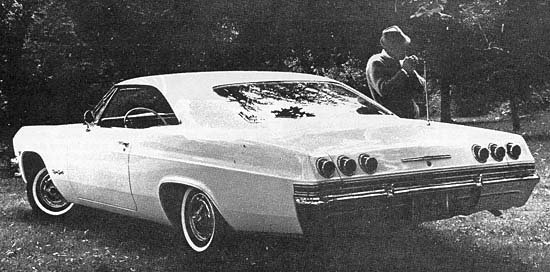

 "She's real fine, my 409," to quote the Beach Boys, but Chevrolet's 409 has changed since it roared onto the American automotive scene in 1961. In those days 409 cubic inches was an awesome quantity, and only Ford's 406 cu. in. version was capable of doing serious battle with the Chevy at the nation's drag strips, stock car races, and stop lights.
"She's real fine, my 409," to quote the Beach Boys, but Chevrolet's 409 has changed since it roared onto the American automotive scene in 1961. In those days 409 cubic inches was an awesome quantity, and only Ford's 406 cu. in. version was capable of doing serious battle with the Chevy at the nation's drag strips, stock car races, and stop lights.
Then Chrysler got serious about the performance race and introduced the 426 cubic inch Ramcharger engines. Ford countered with a powerplant of similar size and suddenly the Chevrolet offering looked a bit anemic by comparison. In 1963 the legendary "porcupine-head" 425 appeared in a pair of Chevrolets at Daytona and ran the opposition ragged while they stayed together. Immediately thereafter the General Motors management got fed up with the moonlight racing at Pontiac and Chevrolet, and the delinquents were summarily yanked in off the street. |
| With the demise of the 425, Chevrolet was left with the 409 as the biggest engine in its stable and it has been marketed in recent model years without a great deal of enthusiasm. Mounted in the Impala chassis, the 300-horsepower 327 engine has made a terribly smooth, adequately powerful unit for those looking
for extra punch in a big Chevy, and the 409 seemed unsuited for widespread sales. The 1965 car blossomed forth as a considerably larger automobile and there is no question that an engine of larger displacement than the regular 327 would be more suitable. The 409 will no doubt suffice for the time being, but there are strong indications that a new, 396 cubic inch engine will be made available in mid-1965. Reportedly set to replace the venerable 409, which began life as a 348 cubic inch truck engine in 1958, the new powerplant will be a direct derivative of the Daytona "porcupine-head".
In present trim, the 1965 Chevrolet Impala is a large, silent automobile, more closely related to the Oldsmobile Dynamic 88 and the Pontiac Catalina than to any of the smaller cars in the General Motors scheme of things. Over two inches longer and wider, the Impala has shed all pretensions of trying to look like a chromed-up economy car and is coming on like a full-fledged member of the medium-priced field. In this context, an engine in the 400 cubic inch range makes sense. After all, Oldsmobile offers a 425 cubic incher as standard equipment; the Mercury's regular engine is 390 cubic inches and the Dodge (383 cu. in.) and Pontiac (389 cu. in.) are certainly in the high displacement category. The 409 has become considerably civilized over the past few years and the car we tested contained a refined 340 hp version equipped with a single Rochester four-barrel carburetor. A higher-compression version (11.0:1) producing 400 hp is available with the excellent Muncie 4-speed transmission, but this model accounts for a very small percentage of sales. Chevrolet provided us with a white Impala hardtop equipped with the Super Sport trim package. The effort has been made to create an impression of competition breeding in the car, via emblems, a beefy transmission console, a gigantic manifold pressure gauge (somewhere in the hallowed precincts of the Chevrolet organization there's a man who is very big on manifold gauges), and instruments rather than lights to measure amperage, oil pressure and water temperature. But the Impala SS still comes off as a smooth, rapid-transport big car of Cadillac-like loveliness. And that's exactly what it is. | 
|
| There is a feeling of quiet pride around Chevrolet that their stylists won the brisk competition within the Corporation to come up with the best sheet metal treatment of the middle-sized "B" body (used by Pontiac, Oldsmobile and Chevrolet). The Impala is an eloquent denial in metal of that hackneyed theory about the intrinsic gaudiness of Detroit cars. The basic shape of the full-sized "B" body is so well-proportioned that no trim of any kind is necessary to deceive the eye. Chevrolet has added a grille and front end treatment that looks "all new," yet manages to retain a strong, link with past models.
Curved window glass is featured on the Chevy line and the hardtop models utilize it in frameless form, which adds to the aura of grace and lightness. But the 1965 Chevrolet is not light and it is not graceful, despite what your eyes persist in telling you. The car weighs over 4200 lbs., ready for the highway, and has a feel-which is most certainly intentional-of great bulk. The interior is insulated from road noise and the automobile moves through the airstream well enough so that the windows may be lowered without blowing the jewelry off the ladies in the back seat. |
 |
Everybody is getting on the wide-track bandwagon and Chevy is no exception. The front track is 2.2 inches wider than last year and the rear has been expanded by 3.1 inches. The front suspension features struts which trail diagonaIly back from the frame mountings to the lower A-arms. The struts are utilized, as with Fords and Cadillacs, to cushion road shock without hampering handling. |
| Short suspension arms and lateral location via a panhard rod are the major additions to the rear suspension. Roll stiffness is substantially increased over 1964, though spring rates have not been upped. |